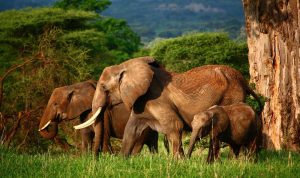Lake Manyara National Park Tanzania
Lake Manyara National Park
This lake was established in 1960 and it is 330 square kilometres in size and over 200 square kilometres is covered by water. It stretches 50 km along the Great Rift Valley escarpments and it offers a virtual microcosm of the safari experience in Tanzania. The park is located 120 kilometres west of Arusha town, on the way to Ngorongoro crater. The park can be reached using the road, charter or the scheduled flight from Arusha or Kilimanjaro airport, as you proceed to Ngorongoro crater and Serengeti National Park.
The things to do in Lake Manyara National park include; game drives, Ultra-light flight, forest hike, nature walks, mountain biking and the night nature walks. This park is mostly known for the tree climbing lions, bushbuck, elephant, zebras, baboons, waterbuck, civet, leopard, buffalos, hippos, and the shy pangolin. The park is also a magnet of bird life as well as the Kaleidoscope of many different species that can be found around the shores including the Flamingos.
The Facilities that are found in the park include; tented camps, campsites, and the lodges that are outside the national park along the Mto Wa Mbu Village guest House that offers comfortable accommodation. Lake Manyara stretches 50 Km along the base of the rusty gold high rift valley escarpment and the park is a scenic gem, with the extolled Ernest Hemingway. This compact game viewing circuit through the Manyara offers a virtual microcosm of Tanzania safari experience.
The park is located in the northern Tanzania and the entrance gate lies 1.5 hours west of Arusha town along the newly surfaced road and it’s close to the ethnically diverse market town of the Mto Wa Mbu. The many activities that are carried out in the park include; game drives, canoeing on water, cultural tours, mountain bike tours, forest walks on the escarpments outside the park. You will visit the park in the dry season in the months of july to October to see the large mammals and in the wet season in the months of November to June for bird watching.
The accommodation facilities include; luxury tree house camp, campsites, public bandas that inside the park. There are also a luxury tented camp and the two lodges that are located on the rift wall overlooking the lake. There are several guest houses and campsites in the Mto wa Mbu.
This lake has got different landscape from any part of the park. . The lush woodlands and the beaches of this rift valley harbour many animals including the giraffes, elephants, and the wildebeest that enjoy the endless water supply. You will also get chance to view animals in the water, sipping, siting or cooling off. There are also many bird species that live in the forests and the ste seeing prize of this area is the tree climbing lions.
Even though the park is small, it’s also impressive since most of the park is covered by the forest or the thick bush, which makes it difficult to spot wildlife. This is the only national park were you can do a night game drive with in the park boundaries. The park is 2.5 hours from Arusha on the road to the Ngorongoro crater found in Ngorongoro Conservation Area. The park can also be visited in one day however, hiking or biking need a separate day. It might be excluded on a short itinerary.
As you look down from the western rift valley wall which is along the road to Ngorongoro and Serengeti, it’s so easy to see why this lake was once described as the Emerald of Africa. This lake also shimmers below with in the heat haze, home to the flamingos, pelicans, and many more water birds. Between the rift and the lake, there stands a lake that has a green colour that contrast with the arid, brown and windswept countryside. Lake Manyara is also renowned for its famous tree climbing lions. These lions climb into the branches to get away from the attention of the flies and the large mammals that threaten them. The park is also reputed to have the highest number of Elephants in the world.
The park is a beautiful small park and is well known for its famous tree climbing lions, elephants and many species of primates including; the vervet monkeys, baboons, and the blue monkeys. The park also has one of the highest concentration of the elephants with in Africa and is also home to the largest number of baboon troops. The park provides the guests with opportunity to see the striking blue monkeys. The national park is also a home to many bird species and animals despite of its size. You can enjoy a short visit to the serene park which will give you the best experience ever.
Some of our prominent packages that include Lake Manyara National Park, you can check out our 11 days honeymoon in Tanzania including safari and Zanzibar beach vacation.
This park also fills over 125 sq. miles of the territory and the shallow alkaline lake consumes majority of the Area. The Great Rift Valley is a rapture in the earth’s surface, dividing the landscape along a fault to over 6500 km all the way from the red sea towards Zambezi River, this river is one of the earth’s geological features which can be seen from the moon. You can view the fantastic rift valley at an altitude of 2000 feet above the lake.
The park is so stunning from whichever direction you approach it from. It’s nested at the base of the Great Rift Valley and its lake appears like the shimmering mirage in the far distance. The water has got a mirror like surface that reflects the shifting shades of the sky above. The wooded slopes that cover the steep escarpments down to the valley are green and rush.
This densely forested slope of the park opens up to a big expanse of the floodplains that surround the lake and meld into the endless plains that are far in the lake and are lost in the far distance. Also the strip of trees that are between the lake and the escarpment is so narrow and the pressure on the elephants are so great, since this park claims the biggest number of elephants in East Africa. The landscape of Lake Manyara National Park is a mosaic of flora and the habitants that live an amazing variety of wildlife, the flora includes; ground water forest, the grassy flood plains, the lake and the acacia woodlands.
Though the scenery is good, game viewing here can be so rewarding at the base of the Great Rift Valley. The resident herbivores you will encounter include; the elephants, hippos, wildebeests, buffalos, wildebeest, warthogs, impalas, monkeys, baboons, and many more. This park also boosts the highest number of baboons in Africa. The many baboons, impalas, elephants can be found in the ground water forest in the area around the park gate. The carnivores animals found here include; lions and leopards, these are also many resident lion pride in the park and are much more difficult to see as compared with the cousins in the Ngorongoro and Serengeti.
The leopards found in the manyara are elusive and are seen by the lucky occasional visitors. In case you like to see a leopard, you can chose to spend two nights in the central Serengeti as the river valley of seronera is the best place to see a leopard in Africa. Lake Manyara is also the best place to watch birds in Africa, it has got over 300 species including the migratory birds as well as the seasoned bird, this lake also attracts lesser and great flamingos along the many other aquatic species. The two interesting species found here include; the long crested eagle and the grey headed kingfisher. We therefore, find it interesting to advise our clients to take a day visit to Lake Manyara as put together with Ngorongoro crater, Arusha, and Tarangire , this type of safari might be good for the travellers.
The Groundwater Forest at Manyara Tanzania
As you make the descent from the ridge of the rift valley, you will encounter the unique habitants as you enter the northern edge of the park and these are the groundwater forest. These are nurtured by a permanent supply of water from the area’s famous water table and the dense evergreen forest of the mahogany trees and the wild date palms tower in front. The forest is covered by gnarled vines and the mossy cover drape at the branches that gives it the ancient and mysterious allure. There are also abundant fresh water springs that spill out from the wall of the Great Rift Valley and the moisture fills from the volcanic rocks into the water table under the surface of the earth.
The water table has really made this forest to survive and it’s high enough that it’s easily tapped by the network of roots that go below the dense growth. The forest was able to grow because it was well watered by the innumerable streams. The landscape here is made up of the baobab trees, shrubs, and the acacia trees. The elephants are found here since they are big funs of the water and the vegetation, there are also the blue monkeys that chase each other through the great leafy shadows, there are also the vervet monkeys, the birds, baboons, and many more.
 The Acacia woodlands at Lake Manyara National Park
The Acacia woodlands at Lake Manyara National Park
Most of the land is covered by the acacia woodlands, and it’s especially common with the flat topped or the umbrella , acacia trees that extend the leafy sun shade over the star grass that cover the ground below. There are also the tamarind and the sausage trees that rise up with a regal presence. The habitant is also favoured by a wide variety of herbivores for the shade and the food that the tree provide.
The giraffes can be seen here gliding through the treetops as they twist the branches with a purposeful care. There are also the impalas, mongoose, leopards, as well as the birds. Within the acacia woodlands, you will find the beautiful species of gardenia, waxy white flowers of the Jove. You will also find the large areas of the shrub land and these include; the bright green toothbrush tree and the grey leaved cordia, you will find the dik dik which is the tiny antelope that finds protection with in the thorny bush. You will also find the elephants that trump through the thickets and the woodlands, in fact Lake Manyara National Park boasts one of the highest elephants in Africa. The park has got over 600 elephants and their behaviour and biology are discussed by the researchers.
The Flood Plains at Lake Manyara National Park
This is a unique habitat of grassy shoreline that emerges during the dry season when the water recedes and it exposes its vast stretches of the land which is alongside the lake. There is also the flat spread of the bare earth which is a waterlogged area during the wet season. There are also the gathering herbivores that gather in these wide open spaces that include the nutrient rich grasses.
Due to the fresh food source and the nice views, many of the different animals gather together to enjoy the feeds. These include; wildebeests, and the zebras that favour the wide open shore spaces of these shoreline plains. There are also the majestic buffalo that dot the landscape as they look like the herds of cattle. There are also the impressive tusked elephants that can be seen enjoying the sun shine on the shore of the lake with the many pink flamingos with in the shallow lake behind them. The other animals that can be seen here include; the giraffes, lions, leopards, hippos, and many more.
There is also the clear shoreline which is good for spotting wildlife since there is obstacle to obstruct your view. This is so amazing to see many different types of animals grazing and living together in perfect harmony. The floodplains make Lake Manyara national park a unique and appealing destination. The lake was also formed as a result of the Great Rift Valley many millions years ago as the rift grew wider and the streams cascaded down wards eroding the slopes and pooled into a lake,
This lake has got algae and this supports large numbers of huge fish. There are also huge and colourful flocks of birds that gather in and near the water in order to feed, these are over 300 different species of birds that have been recorded.




